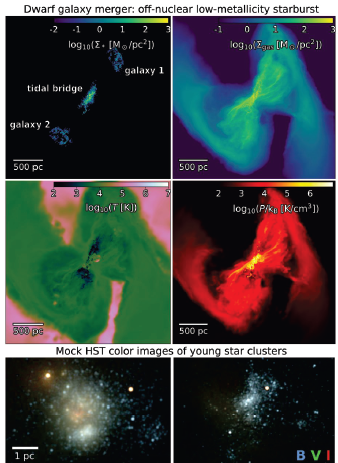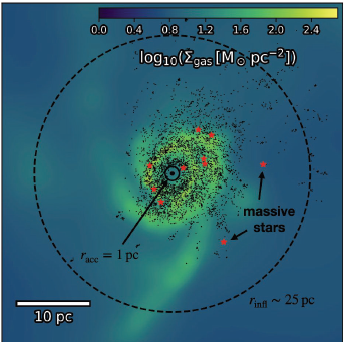ASTROPHYSICS
Galaxy Evolution Including Multiphase Interstellar Medium, Individual Stars and Massive Black Holes
Principal Investigator:
Dr. Natalia Lahén
Affiliation:
Max-Planck-Institut für Astrophysik, Garching, Germany
Local Project ID:
pn49qi
HPC Platform used:
SuperMUC-NG at LRZ
Date published:
Introduction
Globular clusters (GCs) are massive and ancient star clusters populating practically all present-day galaxies. While GCs are frequently found in the galactic outskirts, the central regions of galaxies are occupied by more massive, aptly named nuclear star clusters (NSCs), and massive black holes (MBHs). Due to their ubiquity, GCs, NSCs and MBHs are thought to originate as natural by-products of the extreme gaseous and stellar densities that occur during the assembly of galaxies. The seeds of MBHs may have formed through runaway collisions in dense proto-GCs, and the spatial coexistence of NSCs and MBHs suggests a common mass-growth scenario. Open questions related to the formation of GCs and MBHs still remain: How were the GCs and MBHs able to form already during the first half a billion years? What role did stellar radiation and metal-enrichment play in the formation of GCs and the growth the MBHs? Which came first, star clusters in the galactic nuclei or the MBHs at the centres of galaxies?
Results and Methods
Hydrodynamical simulations of galaxy evolution
This SuperMUC-NG project is a part of the Galaxy Realizations Including Feedback From Individual stars (GRIFFIN) project [1], an ongoing effort to investigate the cycle of star formation, MBH growth and related feedback in low-metallicity environments. To do so, we run high-resolution hydrodynamical simulations of gas-rich dwarf galaxies (Fig 1) with detailed prescriptions for the cooling of the interstellar medium (ISM), star formation, stellar and MBH dynamics, and feedback from stars and MBHs. Our simulation-code SPHGal [1] models the non-equilibrium cooling and heating mechanisms in the multiphase ISM with a chemistry network coupled with modern smoothed particle hydrodynamics methods. Stars between 0.08-500 solar masses are realised individually and supplemented with evolution models that provide details for the spatially resolved interstellar radiation field, photoionising radiation, stellar winds and supernova (SN) blastwaves. The physics of MBHs is modeled with a sink particle accretion prescription, that explicitly tracks the gas-flow from galactic to sub-parsec scales. Below the resolved scales, the orders of magnitude smaller, unresolved black hole accretion disc is modelled with observationally motivated analytical prescriptions. With this technique, the energy output from the unresolved MBH accretion disc (“MBH feedback”) is accounted for.
Gravitational dynamics at high accuracy
For gravitational interactions of individual stars and black holes, we include the publicly available gravitational dynamics module KETJU. KETJU guarantees high accuracy in close-by star-star and star-black hole encounters using the efficient regularised integrator MSTAR [2, 3, Partmann et al. in prep.]. The updated MSTAR combines algorithmic regularisation, a minimum spanning tree coordinate system and the Gragg-Bulirsch-Stoer extrapolation technique. Because the integration of high-precision gravitational dynamics of all stars and black holes across the galaxy would be unfeasibly expensive, the module is spatially limited to operate inside star clusters and in the galactic centre to concentrate the computational resources where it matters most. The addition of collisional dynamics provides a natural source of stars that run or walk away from their birth-environments, directly impacting where and when massive stars release their feedback in the galactic ISM.
Tracing where and when chemical enrichment occurs
Our dwarf galaxy models are populated with tens to hundreds of millions of dark matter, gas, and stellar resolution elements. Gas and star particles, that compose the majority of the particles by number, are encoded with the chemical composition of the baryonic matter in the galaxy. In addition to the 6 chemical species traced in the ISM-chemistry, we follow the abundances of 13 individual chemical elements per particle, making the simulations quite memory-intensive. This allows us to trace how, where and when the chemical composition evolves through enrichment by stellar winds and SNe.
Star clusters within their galactic environment
In [4, 5] we followed, for the first time, the formation and evolution of entire galactic populations of star clusters realised with single stars. In addition to a number of isolated galaxy models, this SuperMUC-NG allocation has been used to simulate a galaxy merger where intense star formation takes place in the tidal bridge between the interacting galaxies (Fig. 1). In this simulation, star clusters with masses up to hundreds of thou-sands of solar masses form rapidly on timescales of less than 5 million years. Because massive stars live for at least a few million years, this timescale is too short for SNe to significantly enrich their nearby regions in heavy elements. Meanwhile, the formation of the most massive clusters takes long enough for the light-metal-enriched wind-material ejected by high-mass stars to be mixed with the ISM and recycled into new stars. We have thus demonstrated how stellar populations with variations in light-element abundances may emerge in nearly uniform-age star clusters, as is often observed in GCs.

Fig. 1: Top: The stellar and gaseous surface density, the temperature and the thermal pressure of the gas in a simulated off-nuclear dwarf galaxy starburst. The simulation follows 20 million gas particles, 8 million old star particles and 3.5 million new single stars. In the tidal bridge star clusters form with masses in excess of 105 solar masses. Bottom: Mock Hubble Space Telescope images of young massive star clusters forming in the tidal bridge.
Feedback-regulated growth of black holes
Recent observations have established that many dwarf galaxies host MBHs, albeit with lower black hole mass compared to more massive galaxies. In Partmann et al. in prep., we explore to which extent MBHs in the expected mass range can grow and how they coevolve with their galactic environment. We find that the growth of MBHs in dwarf galaxies is significantly limited by several physical mechanisms. Because gas accretion onto the black hole and star formation compete over the same supply of dense gas, accretion events (as shown in Fig. 2) typically lead to an increase in star formation around the MBH. The most massive among these young stars emit radiation and explode as SNe at the end of their short lifetime, which can expel gas from the galactic center. Hence, dense gas around the MBH is short lived and the mass growth of the MBH is significantly limited by star formation and the associated stellar feedback. Repeated accretion and central star formation cycles lead to the formation of a small NSC. In addition to stellar feedback, the feedback from the MBH accretion disc is strong enough to stall MBH growth almost completely – a result that is consistent with observations, indicating that more extreme environments than isolated dwarf galaxies are required to grow black holes. Suitable conditions with higher gas densities and more frequent galaxy mergers might have existed in the early Universe, which we will explore in a future project.

Fig. 2: Gas accretion flow inside the central ~25 pc of the galaxy, where the MBH (central black dot) dominates the gravitational potential. Gravitationally trapped gas forms a disc that feeds the MBH and reaches densities that allow for the formation of stars. As soon as the first massive star (red symbols) explodes as a SN, most of the gas will be expelled from the galactic center and the MBH growth stops. The simulation explicitly resolves the accretion flow down to the accretion radius, that is set to 1 pc here.
Ongoing Research / Outlook
The SPHGal-simulations offer a large dynamic range in hydrodynamical quantities and gravitational interactions. The methods outlined above make the simulations uniquely suited for studies of star formation and chemical enrichment, as well as gaseous inflows and outflows in star clusters and in the vicinity of MBHs together with the evolving galactic environment. The unique combination of non-equilibrium ISM chemistry, chemical element tracing and collisional dynamics make the simulations computationally demanding and SuperMUC-NG has provided an invaluable resource for running the largest simulations in the ongoing GRIFFIN project. A number of simulations are still in preparation, and the data products of the simulations run so far will be used in follow-up studies of the baryon-cycle and ISM-structure in and around massive star clusters and the galactic centre.
References and Links
[1] https://wwwmpa.mpa-garching.mpg.de/~naab/griffin-project/
[2] Rantala, A. et al., 2017, ApJ, 840, 1, 53.
[3] Partmann, C. et al., submitted to MNRAS, arXiv:2310.08079.
[4] Lahén, N. et al., 2023, MNRAS, 522, 2, 3092-3116.
[5] Lahén, N., Naab, T., Szécsi, D., 2024, MNRAS, 530, 1, 645-667, arXiv:2402.09518.